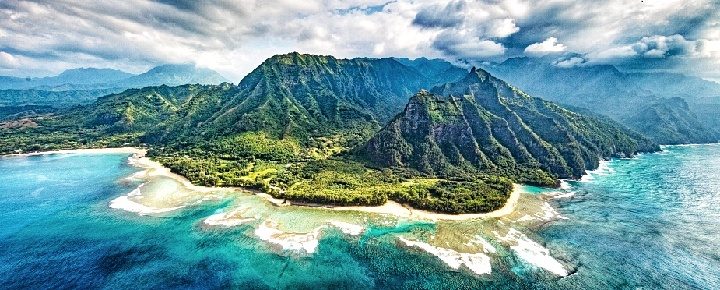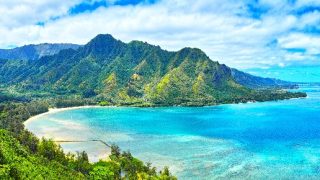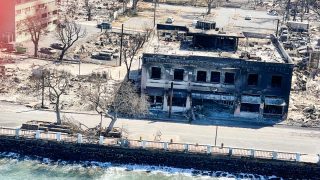It is now widely expected that behemoth Hawaiian Electric Company (HECO) will be forced into bankruptcy by the recent Maui wildfires. Many visitors may not know that it supplies power to 95% of the state. The 5% not included is the island of Kauai, which is largely immune to the fallout, and we’ll tell you why in this article.
Oahu, Maui, Molokai, Lanai, and Big Island residents could see electrical costs soar, and so could visitors.
Hawaiian Electric owns the following electric utilities: Hawaiian Electric Company on Oahu, Hawaii Electric Light Company on the Big Island, and Maui Electric Company, which powers Maui, Lanai and Molokai.
“Hawaiian Electric may collapse after fires, forcing reckoning for utilities. One after another, utilities confront massive liabilities for wildfires. With the Maui fire, Hawaiian Electric faces potential insolvency.”
-The Washington Post
Hawaiian Electric bk would leave Kauai the lone wolf standing in power independence.
How this will impact power and related costs on the other Hawaiian Islands hasn’t been previously reported. But we can anticipate higher prices which will be felt by both visitors and residents alike.
An electric utility bankruptcy will increase the cost of service and could also harm the ability of Hawaii to continue its move forward in renewable energy. This has been seen in other recent bankruptcies elsewhere.
Big payouts associated with the Maui fire may also impair the ability of the utility company to make the necessary upgrades that could help prevent future fires. Undoubtedly, the cost of all this will come directly down to the customers, residents, and visitors across Hawaii, where electric rates are already the highest in the nation.
Electric rates impact Hawaii hotel and vacation rental costs and restaurants, too.
Higher electric rates for Hawaii hotels ultimately lead to increased operating costs, inevitably increasing nightly room rates. Restaurants will also face higher expenses with increased energy costs, resulting in higher menu prices.
Owner of Fairmont Kea Lani, Fairmont Orchid, and Ala Moana Hotel offers worst-case scenario.
“Energy typically accounts for about 8% of total costs, but that could rise as high as 25% in a worst-case scenario.”
-Sebastain Bazin, CEO of Accor.
Indeed, Hawaiian Electric customers on all islands (except Kauai) may face skyrocketing energy bills, which could have a ripple effect on the economy. While at hotels and vacation rentals in Hawaii, it can result in a decrease in the number of room nights sold and a reduction in revenue and profitability.
Impact on Hawaii electricity costs.
While it isn’t clear what impact a Hawaiian Electric insolvency will have on most of Hawaii, the island of Kauai has been insulated from the effects of fuel price fluctuation, which we’ll tell you about below. The State of Hawaii has had a long history of relying on oil as its primary source of electricity generation. For example, in 2021, more than 65% of Hawaii’s power came from oil, and 1/3 of that came from Russian sources. That was before the Ukraine situation, which resulted in the US banning all Russian gas and oil, driving prices even higher.
Hawaiian Electric: since 1891.
Hawaiian Electric Company’s long history dates back to October 13, 1891. It has now expanded to provide power to all of the Hawaiian Islands except Kauai.


Environmentally friendly Kauai boasts solar and Biofuel.
Kauai is the only Hawaii island not supplied by Hawaiian Electric Company. Instead, the consumer-owned Kauai Island Utility Cooperative (KIUC) manages that island’s electricity.
KIUC was formed in 2002 and is one of America’s newest electric cooperatives. There are some 900 U.S. electric cooperatives in the country. KIUC operates as a not-for-profit entity, owned by its members/customers and governed by an elected board of directors.
Under KIUC, Kauai has charged ahead with renewables, and began leaving HECO in the dust long ago. One example is Biofuel, which you may not have ever noticed when visiting the Garden Island.
But, if you’ve ever wondered what is going on with all those closely planted stands of trees along the highway between Halfway Bridge and Omao, here’s the answer. These trees are being grown and harvested for locally produced power.
An 847-acre plot of land seeded with Eucalyptus and Albesia trees and test plots of other species were planted years ago. In all honesty, they weren’t sure exactly what they would do with the trees at the time, but eventually settled on burning them as a fuel source. Later, it was determined that only Eucalyptus should be grown because they are much more energy-dense than Albezia.
There is an ongoing debate about applying the term “carbon neutral” to this type of biomass energy operation, given that the machinery alone needed to harvest, transport, and process trees for burning decidedly tips the balance to being less than 100% carbon neutral. As is the case with many “renewable” energy schemes, there are many other impacts often overlooked.
In any event, such biomass energy is currently considered renewable. It is just one of multiple power generation methods that Kauai has used to position itself farther away from reliance on long-distance importation of fossil fuels. The coop’s current generation portfolio contains a diverse array of renewables, including home-based photovoltaics and massive commercial solar farms spanning the island.
More than 60% of the electricity produced on Kauai is from renewable sources.
Kauai is already far above and beyond the state-mandated milestone of 40% renewable energy generation by 2030. Hawaiian Electric, which serves the other islands, reported 32% renewable in 2022, just about half of Kauai’s production. Previously, Hawaiian Electric said it was still on track to meet the 40% renewable benchmark by 2030, it remains to be seen how this latest disaster will impact this timeline.
West Kauaʻi energy project will move island towards 80% renewables.
Recently, the state appeared to approve permitting and construction of a large-scale project that combines solar, batteries, and pumped hydraulic storage in a system that will also deliver irrigation water.
Barring further complications, that project is set to be operational by 2030 and is set to bring the island’s renewable production up to 80%.
Kauai already generates 100% renewable-sourced daytime energy.
According to KIUC, during the middle of the day, Kauai is often powered by 100% renewable sources, thanks to its ample solar capabilities. However, the output of these systems can vary widely, so adding mass storage will help significantly in offsetting times when power is less available.
As you may know, Hawaii has hoped for the past decade to become 100% renewable energy-based in the next twenty years. While Hawaii as a whole has a long way to go, Kauai is already well on the way.
Kauai jumpstarted Hawaii’s power transition.
The Garden Island has been renewable-focused for years. Kauai is also looking at how to reduce its extreme dependence on automobiles. A plan including improved bus transportation, bicycles, bicycle-sharing, and better walking access is in the works.







BOE,
What happened to the little check box that requested we receive related posts?
And, I still believe we should be able to indicate disagreement with a post. It makes the site more powerful.
Visiting Waikiki Sep 14-30. If you get over that way, send me an email – we can meet for lunch, I’m buying.
Mahalo
Hi Rod.
Mahalo for that help and almost 500 other comments. We see that comment subscription had an issue and we just fixed it. The thumbs down feature was removed by intention to reduce contentious comments. And lastly, thanks, and will do.
Aloha.
The Maui county government should sue themselves. And step down in shame. They did nothing to address wildfire concerns after the 2018 wildfire disaster.
The beginning of this disaster goes back about 175 years when
the water that made Lahaina a lush tropical paradise was diverted
to the sugar cane plantations. 100 hundred years later the sugar cane was replaced with non native grasses which were known to be very flammable. So perhaps you should sue these landowners, HECO and the county.
Great idea!
I’m afraid that will be up to the people. And, everyone actually responsible will band together to make the folks doubt themselves – it’s the way of politicians.
I wouldn’t be surprised at a HECO bankruptcy, but nobody today knows for sure that it will happen. Today I received an email from HECO telling its side of the story, and HECO *may* have some valid points. Attorneys avoid predicting the outcome of litigation.
I own two west Maui properties and had scheduled installation of a solar power system with a tesla battery at my townhome in Puamana, at the south end of Lahaina, for September 14-20. The fire destroyed about 40% of the Puamana community, and my solar system is now on indefinite hold. One of the reasons I planned to get the tesla battery is to avoid paying 44 cents per KWH to HECO for power at night when my panels won’t produce power. There are some weak “buyback” programs that could allow me to sell some excess power back to HECO / the grid, but HECO pays maybe 13 Cents per KHW and apparently the program doesn’t work with tesla batteries. What I think we need is a state or even federal law requiring power companies to buy power not used by owners of solar systems for the same rate they sell the power. Then the grid could substitute for a battery and the percentage of solar produced power would be maximized. If the government can give electric companies a monopoly on grid power, it seems to me that the government can force those companies to make smaller profits so that we can hopefully save this planet and move away from transmitting huge volumes of power through uninsulated power wires on poles.
Your idea of buy back of electric power by the electric companies is totally unrealistic you must be from the government.
The whole point of having a public utility commission is to protect the public from the incompetence of mgt thats for shareholders to deal with as they get a vote. So shouldnt be that way. Reality is its going to cost several million dlrs to bury the power lines vs just go to fuel cells and pipe and or truck the green hydrogen in. The later will have much less capex so will cost less all around to the point that a rate reduction would be possible.
Consider burying power lines underground maybe? Solves a lot of problems, but a a price.
I believe that your news should focus on the legitimacy and probability of HECO’s potential bankruptcy based on Maui County’s alleged claim. There is sufficient validity to claims that the County had failed to responsibility prevent the disastrous effects of the fire.
Two sides of the story would be appreciated. You worry about the rising cost of travel while we worry about the Government taking care of its people!
In California, even if you don’t live in an area impacted by wildfires, PG & E passes the costs on to all their consumers by other “small” increases that our CPUC approves for PGE every year. I imagine the Hawaiian utility would end up doing the same; especially if they have shareholders to answer to. It’s unfortunate the customers pay the price for a company’s mismanagement. The last thing Maui residents need is another financial burden.